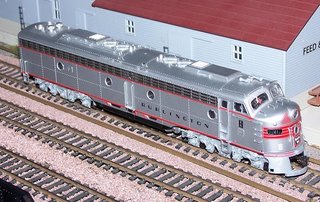I noticed on
Walthers web site that the first of the new HO scale empire builder cars has arrived. Walthers is the distributer of these cars so it will take a few days for my pre-ordered car to arrive at Caboose Hobbies in Denver. Walthers is producing accurate models of the entire Great Northern Empire Builder. You can see their artwork
here.
The actual full size train was made up of these cars but in some cases there was more than one of each type. For instance, there would have been 3 of the shorter dome cars and two of the 7-4-3-1 sleeper cars and two of the 6-5-2 sleeper cars. The entire train could have been 18 cars! That’s too long for my HO layout so I’m going to make mine 10 cars:
1. Baggage-Dormitory
2. 60-Seat Coach
4. 48-Seat Vista Dome Coach
3. 48-Seat Vista Dome Coach
5. Ranch Coffee Shop Lounge
6. "Lake" Series Diner
7. Full Length Great Dome
8. “River" Series 7-4-3-1 Sleeper
9. "Pass" Series 6-5-2 Sleeper
10. “Coulee" Series 6-4-1 Observation
I might add a plain baggage car if the one they are going to release late in 2007 matches this train (it's not part of the set).
The Empire Builder was a Great Northern train. You can read all about it on this
web site. The train ran between Chicago and Seattle. However, the Great Northern Railway only went as far east as St. Paul, Minnesota. The train was operated by the Chicago, Burlington, and Quincy between there and Chicago. Since it is this part of the route that I am going to base my model on, my train will be pulled by silver Burlington engines rather than the attractive Great Northern engines shown in the Walthers page.
I acquired a Burlington E7A and an E8A several years ago to pull a model of the California Zephyr. These are Life Like Proto 2000 models. I hadn’t run them for a long time in favor of other models but recently dug them out in preparation for the arrival of the Empire Builder cars. I got motivated to add some additional detailing to them.
Here is a picture of the E7A number 9924A:

Here is a picture of the E8A number 9941B:

These models were very detailed right out of the box. The extra details that I have added so far make them stand out even more. Mostly what I did was add additional grab irons on the cab, nose and roof. There is a lot more that can still be done.
Information about proper placement of these details can be found in various publications and web sites. For instance, here is a link to
a picture of the full size 9941B.
It is also interesting to notice how this railroad was inconsistent in its paint schemes. For instance, notice the difference in the color and number of stripes on the front of the locomotives.
Many of the Burlington E7’s and E8’s had their side frames replaced with stainless steel the entire length of the locomotive behind the cab. These two never had that done.
I am looking forward to completing my Empire Builder. Unfortunately, it wall take almost a year since the cars are being release about one per month.









